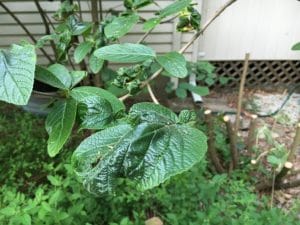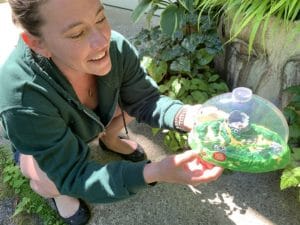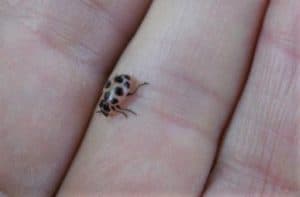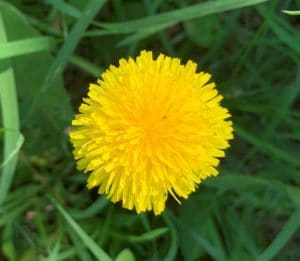Hello Fellow Readers, Sometimes, I think I should’ve been a bug expert given all the garden dilemmas from insects that folks ask about. Fortunately, there are also beneficial bugs, such as the much-loved ladybugs.
Aphid remedies before introducing beneficial ladybugs
For sure many insects can cause havoc, like the aphids that devastated our three Leatherleaf Viburnum resulting in desperate measures to rejuvenate the plant. I cut the plants down to sticks in a moment of frustration (each of the multi-stems at different heights) and then tossed the infested foliage far, far into the woods. Better still would have been to throw the debris in garbage bags for the landfill, not that I wish to contribute to mountains of trash. But I’m ahead of myself in the story.
Gratefully the Viburnum rhytidophyllum rebounded beautifully after a few years of recovery. Then, this spring, the darn little suckers returned. I used the tried-and-true Neem oil three times in five to seven-day intervals as prescribed, trying to stay ahead of the population of tiny dark greyish-green critters that suck sap from the leaves causing them to curl. Neem oil is a natural oil that comes from a Neem tree that discourages fungi and parasites.
I even hand-pinched each withered leaf, more than I can count, tossing them into a Ziplock then the trash for good riddance. But the darn aphids were winning. And so, out came the heavy-hitter in my natural/organic arsenal – a Spinosad called Bull’s Eye. Like Neem oil, it’s safe for people, pets, and the environment and seems to have done the trick on the Viburnum.
A kind neighbor offered her “twelve little ladies”
Now the sons of guns jumped onto the Hydrangea in the front of the house! My kind neighbor Monica came to the rescue with her adopted beneficial ladybugs that served as educational experiments for her kids. She offered them as lacewings, plentiful in her yard, are managing her aphids. She hand-delivered the cute little Ladybug Land with twelve little ladies ready to do their work.
Ladybugs (Hippodamia convergens) are beneficial beetles that you can buy via mail order for your garden. Also known as lady beetles (they aren’t technically bugs), they can eat fifty aphids a day or 5,000 in their three-year lifetime. Ladybugs also feed on other pests, including mites, leafhoppers, scales, and mealybugs.
Beneficial Ladybugs do not swarm inside homes
Not to be confused by the Asian lady beetle (Harmonia axyridis) introduced by the U.S. Department of Agriculture for biological control, first in Pennsylvania in 1978. They vary in color just as ladybugs do— from yellow, orange to red, but have a distinctive M-mark on their whitish heads as compared to our native ladybugs. And while they too eat aphids and such, they are the frustrating little critters that swarm inside homes to hibernate.
It was fun to release the little ladies. And while I haven’t been able to find them at work, the Hydrangea looks happier and are now about to bloom.
How to attract beneficial ladybugs
They sell ladybug lures they say attracts them that sounds iffy to me. Instead, why not plant plants to attract them, such as dill, garlic, parsley, chives, mint, and cilantro. Calendula is one of their favorites, along with geranium, sweet alyssum, yarrow, Queen Anne’s lace, and butterfly weed, to name a few. They’re even fond of dandelions. And so luring ladybugs is another reason to keep those glorious yellow faces in your herbicides and pesticide-free lawn.
Garden Dilemmas? AskMaryStone@gmail.com (and now on your favorite Podcast App.)
You’ll enjoy the story of our Leatherleaf Viburnum recovery in a previous column – Reasons to Prune.
This column is featured in Episode 29 of the Garden Dilemmas Podcast
About my “go-to” Neem Oil and Spinosad
Column updated June 6, 2021







